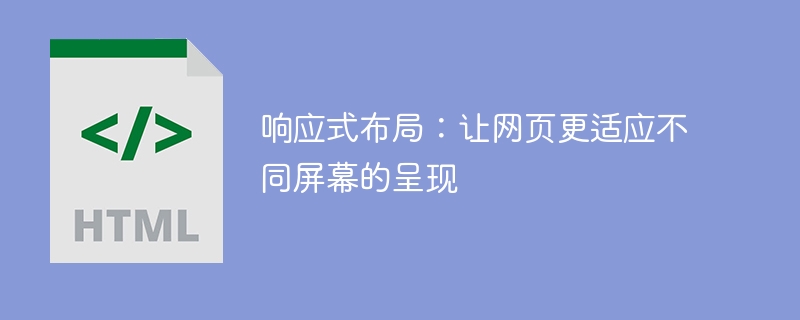

Responsive layout: Make web pages more adaptable to the presentation of different screens
With the popularity of mobile devices and the rapid development of the Internet, more and more people are beginning to use Use mobile devices such as mobile phones and tablets to browse the web. The screen sizes of these mobile devices vary from small to large. In order to display web content well on the screens of different devices, responsive layout came into being.
What is responsive layout? In short, responsive layout means that a web page can adapt to different screen sizes according to the user's device screen size. It uses technologies such as CSS media queries and elastic grids to enable web pages to achieve the best rendering effect on different devices.
The benefits of responsive layout are self-evident. First, it can provide a better user experience. Regardless of whether the user is using a mobile phone, tablet or computer, the web page can automatically adjust its layout to ensure that users can read and operate conveniently. Second, it saves developers time and effort. A single responsive layout can work across multiple devices without the need to develop multiple different versions. This not only reduces development costs, but also speeds up the development cycle. Additionally, responsive layouts can help improve your website’s search engine rankings. According to Google’s algorithm update, responsive websites will rank higher in search results.
To implement responsive layout, the first thing to consider is the visible area of the web page. The visible area of the device screen refers to the area occupied by the system UI such as the toolbar and status bar, and only the area where the browser displays the page is considered. The size of the visible area of different devices varies greatly, so the layout of the web page needs to be determined based on the actual situation.
Secondly, you need to use CSS media queries to define styles for different screen sizes. Media queries allow you to select appropriate CSS styles based on the width and height of the screen. For example, when the screen width is smaller than a certain value, the text size and line spacing can be adjusted so that it can be displayed normally on a small screen.
In addition, elastic grid is also an important technology to achieve responsive layout. Flexible Grid is a grid layout system that automatically adapts to different screen widths. It uses percentages to define column widths rather than fixed pixel values. In this way, the grid can automatically adjust the layout according to the width of the screen, so that the web page can be displayed normally on devices of different sizes.
In addition to the above two technologies, there are some other technologies that can be used to implement responsive layout, such as the dpi attribute in media queries, the use of fluid images, etc. These technologies are designed to allow web pages to better adapt to the presentation of different screens.
In short, responsive layout is a technology that allows web pages to adjust their layout adaptively on different devices. It can provide a better user experience, save development costs, and improve search engine rankings. To implement a responsive layout, you need to consider the visible area of the web page and use technologies such as CSS media queries and elastic grids. With the popularity of mobile devices, responsive layout will become more important to help web pages present the best results on different devices.
The above is the detailed content of Responsive layout: Make web pages more adaptable to different screens. For more information, please follow other related articles on the PHP Chinese website!




